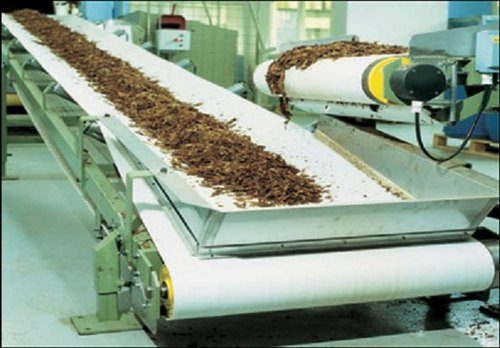
Tobacco Conveying Belts
| Price per Unit | Meter |
| Usage/Application | Trough Conveying |
| Material | PVC & PU |
| Belt Width | 40 – 100 mm |
| Brand | DERCO, Holland |
| Belt Thickness | 10 – 100 mm |
| Packaging Type | STANDARD |
| Color | White & Green |
| Structure | Belt Conveyor |
**Introduction to Tobacco Conveying Belts:**
– Tobacco conveying belts are specialized conveyor belts designed to handle the unique demands of the tobacco industry. These belts are essential for the efficient and hygienic transport of tobacco leaves and products through various stages of production, including processing, drying, cutting, and packaging. The belts must meet stringent requirements to ensure product quality and operational efficiency.
**Construction and Design:**
– Tobacco conveying belts are typically constructed from high-quality materials such as polyester, felt, or other synthetic fabrics that provide strength and flexibility. These materials are often coated with PVC, PU, or silicone to enhance their durability and resistance to tobacco-specific challenges such as moisture, oils, and chemicals. The surface of the belt can be smooth or patterned, depending on the specific application needs, with some designs featuring perforations to allow airflow for drying processes. The belts are designed to be gentle on the delicate tobacco leaves, minimizing damage and ensuring smooth transportation.
**Applications Across Industries:**
– Tobacco conveying belts are used extensively across various stages of tobacco processing. In the primary processing phase, these belts transport harvested tobacco leaves to drying and curing facilities, ensuring even and consistent drying. During the secondary processing phase, the belts carry the dried tobacco to cutting machines, where it is prepared for blending and flavoring. Additionally, in the packaging stage, tobacco conveying belts handle the final products, such as cigarettes and cigars, ensuring they are transported to packaging machines efficiently and without contamination. These belts are also used in the transport of by-products and waste materials, ensuring a clean and efficient production environment.
**Advantages and Benefits:**
– The use of specialized tobacco conveying belts offers numerous advantages. Their construction materials provide excellent resistance to the oils and chemicals inherent in tobacco processing, ensuring long belt life and reduced maintenance. The belts’ ability to handle moisture and temperature variations makes them ideal for both drying and curing processes. Additionally, the gentle handling provided by these belts helps maintain the quality and integrity of the tobacco leaves, reducing waste and improving product consistency. The belts are also designed to be easy to clean, promoting hygiene and preventing cross-contamination between different batches of tobacco.
**Key Parameters for Design:**
– When designing tobacco conveying belts, several key parameters must be considered to ensure optimal performance. Material selection is crucial, with a focus on durability, flexibility, and resistance to tobacco-specific challenges. The belt’s surface texture must be chosen based on the type of tobacco being processed and the specific stage of production. Perforations and patterns may be included to facilitate airflow and drying. Additionally, belt width and length should be tailored to the conveyor system and the volume of tobacco being transported. Consideration of hygiene and ease of cleaning is also essential to maintain product quality.
**Conclusion:**
– Tobacco conveying belts are vital for efficient and hygienic tobacco processing. Their specialized construction and design cater to the unique demands of the tobacco industry, ensuring durability, flexibility, and resistance to moisture, oils, and chemicals. By carefully selecting and designing these belts to meet specific application requirements, the tobacco industry can optimize production processes, enhance product quality, and ensure smooth and efficient transport of tobacco leaves and products through all stages of processing and packaging.

